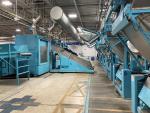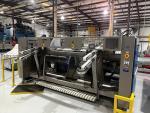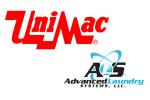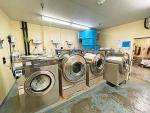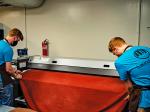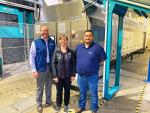CHICAGO — Upgrades are a constant in the laundry and linen services industry.
Some operations need to improve quality and efficiency. Others have acquired older facilities in desperate need of upgrades.
Sometimes equipment simply wears out.
Costs, labor issues, government regulations … there are many reasons for industrial laundries to update equipment and facilities.
American Laundry News reached out to several laundry operators and equipment manufacturers to find out which upgrades have been requested most recently, the reasons for the upgrades and how operations have been improved.
MORE MANUFACTURER OBSERVATIONS
Nate Murchison, vice president of customer support, and Scott Voss, vice president of technical engineering, for Ellis Corp. & Ludell Manufacturing in Itasca, Illinois, say in recent years, the company’s industrial laundry customers have often requested upgrades for their equipment with the most popular being dryers, water systems, and dissolved air flotation (DAF) systems.
Upgrades to the machine controls have also been a significant focus.
“The motivation behind these requests is multifaceted,” share Murchison and Voss. “Replacing outdated dryers with energy-efficient models has been a key strategy to reduce gas consumption. Additionally, enhancing heat recovery systems with technologies like Ellis’s Auto-Balance and UpTime® controllers have maximized energy savings, which can result in saving thousands of dollars each month.
“The installation of our DAFs is another common upgrade driven by the need to comply with local compliance limits and to avoid surcharges as municipal waste treatment facilities reach capacity.
“Finally, the inefficiency and maintenance difficulties of older controls, compounded by supply-chain issues, have led to upgrades in this area. These newer controls not only bridge the gap in sophistication but also offer easier navigation and troubleshooting, which is particularly beneficial for less experienced maintenance personnel.”
The primary challenge in implementing these upgrades has been the financial investment required, says Murchison and Voss.
“Capital upgrades demand a considerable financial commitment, which is often a hurdle for many in the industry,” they point out.
The two point out that Ellis has made a significant impact in assisting customers with their industrial laundry upgrades.
“Our customers acknowledge that if it weren’t for Ellis’s guidance, the prolonged issues they faced with their old machines would have continued to drain their resources,” they say.
“Thanks to the upgrades facilitated by Ellis, they have seen a clear return on investment and substantial resource savings, emphasizing the importance of Ellis’s support in proactive equipment management.”
Jim Shaw, vice president and national accounts sales manager for Lavatec Laundry Technology based in Beacon Falls, Connecticut, says that some of the most significant requests for upgrades the company fields revolve around a lower cost to own, improving productivity with more throughput per hour, optimizing energy usage, reducing labor and operator fatigue through automation, and improving the quality of the finished product.
“By utilizing better equipment designs and avoiding proprietary parts, Lavatec keeps the ‘cost to own’ to approximately 1.5 to 2% annually, whereas competitive designs can cost as much as 7-8% in parts on an annual basis,” he says.
“Our design upgrades include the Lavatec Cascade Drying system, which optimizes energy, reduces labor and improves productivity. The system recirculates the exhaust through a three-phase process. It keeps the energy within the system by optimizing the energy usage and is fully automated to process six loads of full dry goods per hour.
“We also offer the Lavatec Line Burner with a modulating gas valve. The valve reduces gas consumption, and the line burner distributes the heat evenly across the length of the cylinder, eliminating hot spots and the damage caused to polyester-based products, cotton towels, and the rippling in walk-off mats caused by overheating.
“Lastly, the Infrared Red sensor option is programmed to read the temperature of the products in the cylinder to deliver a finished product with the desired moisture content.”
Shaw says Lavatec’s customers are impressed by the lower cost to own and with the more throughput per operator hour and per square foot ratios provided by recent upgrades.
“They have also reported better finished products with reduced damage and a decrease in utility costs,” he shares.
Brock Pellerin, vice president of Pellerin Milnor Corp. in Kenner, Louisiana, says the company doesn’t do much with upgrades on individual machines, adding that the machinery Milnor provides is generally flexible enough to handle and manage most tasks and changes over time.
“New machinery considerations tend to focus on labor savings and sustainability (reduction of utility requirements),” he points out.
“Occasionally, we will receive machinery inquiries relating to governmental mandates, such as wastewater limits, air quality management district emission requirements, etc.
“In some instances, a change in buildings due to lease expiration, growth (need more space) or logistical changes create the need for new machinery.
“We also get asked about software upgrades when available. Customers are looking for data management applications and they are looking for equipment that can integrate into these platforms.”
Pellerin says the changes have been requested because of labor availability, changes in utility cost and governmental regulations.
He shares that budgeting and financing are challenges laundries face when considering upgrades.
“Usually a thorough ROI (return on investment) is needed to justify investment to obtain financing,” Pellerin says. “Sometimes, the issues are space availability in the laundry facility.”
He concludes that with upgrades, operators see a reduction in labor requirements, ergonomic improvement, utility and space savings, and regulatory compliance.
Like Pellerin, Joe Fleming, national sales manager for Yamamoto North America in Bloomington, Illinois, says that the company’s equipment types haven’t changed a whole lot because many of the trends in the industry already align with Yamamoto’s equipment portfolio.
For example: water reclamation, reduced footprints, increased efficiencies, etc.
“If there’s anything we’re working on that’s come from the request of our industrial/light industrial it’s the tilt feature on our WUN150,” he shares. “Although that load size is petite for most operators in this market, there are plenty of small operators that would love the feature to prevent employee injury risks and increase the unloading speed.
“Yamamoto prides itself on providing world-class quality for a competitive price. Tilt features and some of the other features that customers are interested in are not cheap modifications.
“They also add another level of complexity to equipment that could cause failures over time, assuring that we can engineer the new features effectively to meet our standards is the first challenge.
“Making sure it doesn’t price our equipment out of the market is the next.”
Fleming says that with its already implemented reclaim systems, reduced footprints and other top-tier features, Yamamoto has received outstanding feedback.
“We enjoy being the best option for our customers,” he says. “By continuing to advance our equipment’s capabilities we are excited to grow with more clients in this market.”
Read upgrade stories from operators in Part 1 by clicking HERE.
More manufacturer insights can be found in Part 2 HERE.
Have a question or comment? E-mail our editor Matt Poe at [email protected].


